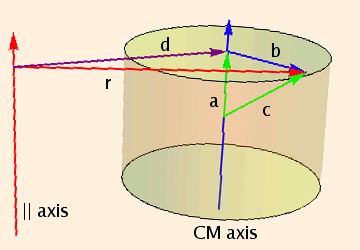
| (prev) | (top) | (next) |
Moments of inertia are computed the same way as volumes of surfaces of revolution, with the integrands multiplied
by the density and the square of the distance to the volume element. You may find the following table of moments of inertia useful:
we see that
= M d2 + Icm + 2 d ⋅ ∫ (c - a) dm
τ = r ⊗ F
Angular Motion
θ ≡ x / r
(Note that r is a constant.)
θ is measured as a fraction of a circle in radians (π rad = 180 degrees)
and therefore has no physical units. θ = 0 is conventionally taken to be along the positive x axis, with θ
increasing with counterclockwise rotation:
ω ≡ dθ/dt = v / r (angular velocity)
α ≡ d2θ/dt2 = a / r (angular acceleration)

I ≡ ∫ r ⋅ r dm
where r is the vector perpendicular to the axis of rotation and pointing to the mass dm.
cylinder, about symmetry axis m r2 / 2 cylinder with a hole, about symmetry axis m (rinner2 + router2) / 2 ring, about symmetry axis m r2 rod, about center m l2/ 12 rod, about end m l2 / 3 sphere, about diameter 2 m r2 / 5 spherical shell, about diameter 2 m r2 / 3
L = I ω
For rolling objects, the angular momentum and energy include contributions both from the rotation of the object about its own center of mass, and
from the linear (translational) motion of the center of mass.
τ = I α
Krot = I ω2 / 2
An object that rolls without slipping requires static friction in order roll, but since for every revolution its center of mass moves one circumference, there is no
displacement parallel to the frictional force, and so no work is done by friction:
The gravitational potential energy of a rotating object is determined by the position of its center of mass.
Ktotal = Ktranslational + Krotational.
Only if an object rolls with slippage, or slides without rolling, does friction cause dissipation of energy.
I = Icm + M d2,
where Icm is the moment of inertia through the center of mass, M is the mass of the object and d is the perpendicular
distance between the parallel axes. Referring to this figure:

∫ r ⋅ r dm = ∫ (d + b) ⋅ (d + b) dm
but d ⋅ a = 0 and ∫ c dm = 0 because the origin of c is the center of mass.
= ∫ (d ⋅ d + b ⋅ b + 2 b ⋅ d) dm
L = r ⊗ p
(with axes of rotation passing through the origin of r). r is called the lever arm.
Note that point objects moving linearly can have angular momentum. For instance, an object of mass m moving at speed v along the line y = b has
angular momentum with respect to the origin
Note that the units of torque are Newton-meters, not Joules. Work results from a force exerted parallel to the direction of motion;
torque results from a force exerted perpendicular to both the lever arm and the axis of rotation.
L = (v * t, b, 0) ⊗ m (v, 0, 0)
= (0, 0, - b m v)
ΔL = ∫ τexternal dt
Note that:
| (prev) | (top) | (next) |
©2011, Kenneth R. Koehler. All Rights Reserved. This document may be freely reproduced provided that this copyright notice is included.
Please send comments or suggestions to the author.